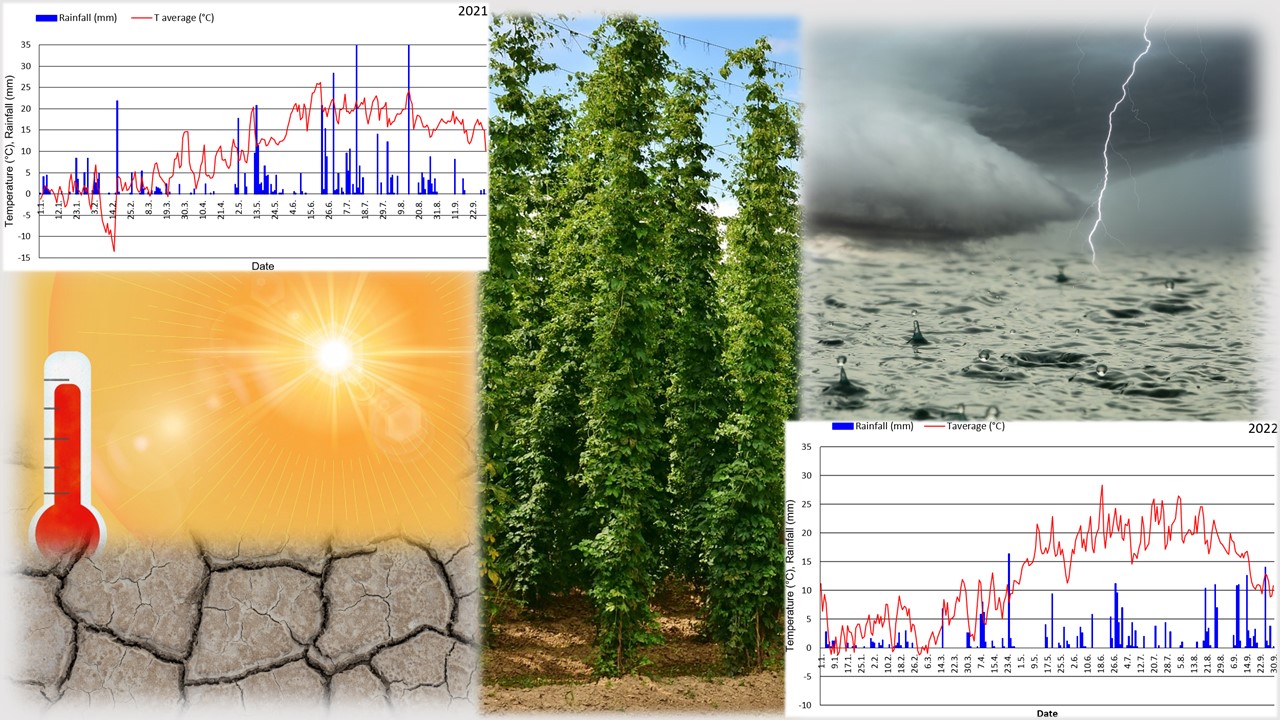Hop cultivation vs. weather – an eternal theme
(Evaluation of the crop harvest 2019–2022 of Czech hop varieties at Stekník farm)
DOI:
https://doi.org/10.18832/kp2023.69.822Keywords:
hops, alpha acids, yield, global warning, irrigationAbstract
The course of weather conditions during the growing season, but also beyond it, decides the economics of hop cultivation every year. Ongoing climate changes manifested by more frequent occurrence of compound hot and dry waves affect hop cultivation not only in the Czech Republic, but in the entire region of Central Europe. The paper evaluates the harvest results (yields, alpha acid content) of four Czech hop varieties in the period 2019–2022 with a focus on the weather diametrically opposed vintages 2021 and 2022 on a specific agricultural farm in the Žatec (Saaz) hop-growing region. While the 2021 vintage was rich in precipitation in the decisive vegetation phase, the 2022 vintage was very dry and hot. The age of the plants significantly influenced the alpha acid content of the varieties Saaz, Sládek and Premiant independently of the vintage. Young growths of the Saaz variety contained at least 60% rel. more alpha acids than older growths (more than 5 years old), while the increase in the Sládek variety was 30–40% rel. and in the Premiant variety 20–25% rel. In the case of the variety Agnus, the age of the plants did not have a demonstrable effect on the content of alpha acids. In 2021 the yields of all varieties were negatively affected by the calamitous occurrence of downy mildew. In 2022, the rainfall deficit was so large that it could not be fully compensated even by the maximum use of drip irrigation. Of the evaluated varieties, the Agnus variety coped best with the different weather conditions of the assessed vintages. This shows that the cultivation of climate resistant varieties is one of the promising but time-consuming ways to face the expected climate changes. Other options include regular renewal of hop growths, consistent regionalization, i.e. planting hop in locations that are suitable for the given variety and efficient use of irrigation systems.
References
Bauerle, W. L. (2023). Humulus lupulus L. Strobilus Photosynthetic Capacity and Carbon Assimilation. Plants, 12(9), 1816. https://doi.org/10.3390/plants12091816
Bauerle, W. L., Hazlett, M. (2023). Humulus lupulus L. Strobilus In Situ Photosynthesis and Respitation Temperature Responses. Plants, 12(10), 2030. https://doi.org/10.3390/plants12102030
Brant, V., Krofta, K., Kroulík, M., Zábranský, P., Procházka, P., Pokorný, J. (2020). Distribution of root system of hop plants in hop gardens with regular rows cultivation. Plant, Soil and Environment, 66(7), 317–326. https://doi.org/10.17221/672/2019-PSE
Donner, P., Pokorný, J., Ježek, J., Krofta, K., Patzak, J., Pulkrábek, J. (2020). Influence of weather conditions, irrigation and plant age on yield and alpha-acids content of Czech hop (Humulus lupulus L.) cultivars. Plant, Soil and Environment, 66(1), 41–46. https://doi.org/10.17221/627/2019-PSE
EBC Analytica (2019). Method 7.4 - Lead conductance value of hops, powders and pellets. In: EBC Analysis Committee-Nürnberg (ed.). Analytiva EBC, Hans Carl Get-ränke Fachverlag, Chap. 7.4
Eriksen, R., Rutto, L., Dombrowski, J., Henning, J. (2020). Photosynthetic Activity of Six Hop (Humulus lupulus L.) Cultivars under Different Temperature Treatment. HortScience, 55(4), 403–409. https://doi.org/10.21273/HORTSCI14580-19
Fandino, M., Olmedo, J. L.; Martínez, E. M., Valladares, J., Paredes, P., Rey, B. J., Mota, M., Cancela, J. J., Pereira, L. S. (2015). Assessing and modelling water use and the partition of evapotranspiration of irrigated hop (Humulus lupulus), and relations of transpiration with hops yield and alpha-acids. Industrial Crops and Products, 77, 204–217. https://doi.org/10.1016/j.indcrop.2015.08.042
Fischer, E. M., Schär, C. (2010). Consistent geographical patterns of changes in high-impact European heatwaves. Nature Geoscience, 3, 398–403. https://doi.org/10.1038/ngeo866
Ježek, J., Donner, P., Křivská R., Klapal I. (2021). Assessment of the agrometeorological year 2020/2021 in Žatec, Liběšice near Úštěk and Tršice near Olomouc. Chmelařství, 94(11–12), 122–132. (Available only In Czech)
Ježek, J., Donner, P., Křivská R., Klapal I. (2022). Assessment of the agrometeorological year 2021/2022 in Žatec, Liběšice u Úštěka and Tršice u Olomouce. Chmelařství, 95(10–12), 110–119. (Available only In Czech)
Krofta, K., Kroupa, F. (1995). Evaluation of analytical indicators of Czech hops in 1994. Chmelařství, 68(5), 59–64. (Available only In Czech)
Krofta, K. (2002). Content and composition of hop resins of Saaz hops in terms of their brewing value. Ph.D. Thesis, VŠCHT Praha. (Available only In Czech)
Krofta, K., Klapal, I., Vojtěchová, D., Tichá, J. (2020). Evaluation of quality parameters of Czech hops from the 2019 harvest. Chmelařství, 93(1–2), 7–15. (Available only In Czech)
Krofta, K., Fritschvá, G., Kroupa, F., Tichá, J. (2023). Evaluation of quality indicators of Czech hops from the 2022 harvest. Chmelařství, 96(1–3), 6–11. (Available only In Czech)
Kršková, I. (2021). Hop harvest is the highest in 25 years. Chmelařství, 94, 141–42. (Available only In Czech)
Kršková, I. (2023). Hop harvest is lowest in a decade. Chmelařství, 96, 20–21. (Available only In Czech)
Kučera, J., Krofta, K. (2009). Mathematical model for prediction of alpha acid content in Saaz aroma variety. Acta Horticulturae, 848, 131–139. https://doi.org/10.17660/ActaHortic.2009.848.14
Matoušek, J., Trněná, L., Svoboda, P., Růžková, P. (1994). Analysis of hop latent viroid (HLVd) in commercial hop clones in Czech Republic. Rostlinná Výroba, 40, 973–983.
Matoušek, J., Patzak, J., Oriniaková, P., Chrástková, V., Svoboda, P. (1997). Genotype-dependent sensitivity of hop (Humulus lupulus L.) to HLVd infection, HLVd sequence stability and its field distribution within Žatec hop collection garden. Proc. Sci. Comm. IHGC, Žatec, July 29-August 1, 87–94.
Mikyška, A., Krofta, K., Fritschová, G., Belešová, K., Kroupa, F., Tichá, J. (2023). Alpha acids content in Czech hops from harvest 2022 - forecast, reality and trends. Kvasny Prumysl, 69(1), 692–699. https://doi.org/10.18832/kp2023.69.692
Mozny, M., Tolasz, R., Nekovar, J., Sparks, T., Trnka, M., Zalud, Z. (2009). The impact of climate change on the yield and quality of Saaz hops in the Czech Republic. Agricultural and Forest Meteorology, 149(6–7), 913–919. https://doi.org/10.1016/j.agrformet.2009.02.006
Mozny, M., Trnka, M., Vlach, V., Zalud Z., Cejka, T., Hajkova, L., Potopova, V., Semenov, M., A., Semeradova, D., Büntgen, U. (2023). Climate-induced decline in the quality and quantity of European hops call for immediate adaptation measures. Nature Communications,14, 6028. https://doi.org/10.1038/s41467-023-41474-5
Nakawuka, P., Peters, T. R., Kenny, S., Walsh, G. (2017). Effect of deficit irrigation on yield quantity, water productivity and economic returns of four cultivars of hops in the Yakima Valley, Washington State. Industrial Crops and Products, 98, 82–92. https://doi.org/10.1016/j.indcrop.2017.01.037
Patzak, J., Matoušek, J., Krofta, K., Svoboda, P. (2001). Hop latent viroid (HLVd) – caused pathogenesis: effects of HLVd infection on lupulin composition of meristem culture-derived hop (Humulus lupulus L.). Biologia Plantarum, 44, 579–585. https://doi.org/10.1023/A:1013798821676
Patzak, J., Henychová, A., Krofta, K., Svoboda, P., Malířová, I. (2021). The influence of Hop latent viroid (HLVd) infection on genes expression and secondary metabolites in hop (Humulus lupulus L.) glandular trichomes. Plants, 10(11), 2297. https://doi.org/10.3390/plants10112297
Perkins, S. E., Alexander, L. V. (2013). On the measurrement of heat waves. Journal of Climate, 26, 4500–4517. https://doi.org/10.1175/JCLI-D-12-00383.1
Potopová, V., Lhotka, O., Možný, M., Musiolková, M. (2021). Vulnerability of hop-yields due to compound drought and heat events over European key-hop regions. International Journal of Climatology, 41 (S1), E3136–E2158. https://doi.org/10.1002/joc.6836
Russo, S., Sillmann, J., Fischer, E. M. (2014). Magnitude of extreme heat waves in present climate and their projection in a warming world. Journal of Geophysical Research Atmospheres, 119(22), 12500–12512. https://doi.org/10.1002/2014JD022098
Russo, S., Sillmann, J., Fischer, E.M. (2015). Top ten European heatwaves since 1950 and their occurrence in the coming decades. Environmental Research Letters, 10, 124003. https://doi.org/10.1088/1748-9326/10/12/124003
Sedlmaier, K., Feldmann, H., Schädler, G. (2018). Compound summer temperature and precipitation extremes over central Europe. Theoretical and Applied Climatology, 131, 1493–1501. https://doi.org/10.1007/s00704-017-2061-5
Slavík, L., Kopecký, J. (1997). Irrigation efficiency of hops in different rainfall years. Chmelařství, 70(4), 44–46. (Available only In Czech)

Downloads
Published
How to Cite
Issue
Section
License
Copyright (c) 2023 Karel Krofta, Jaroslav Pokorný

This work is licensed under a Creative Commons Attribution 4.0 International License.







